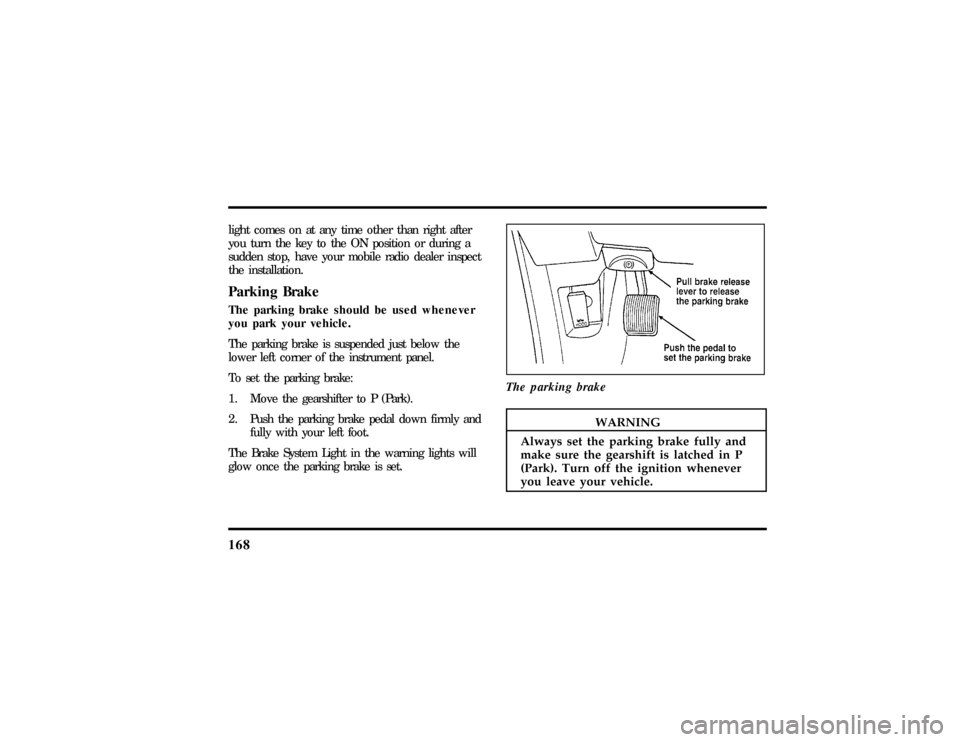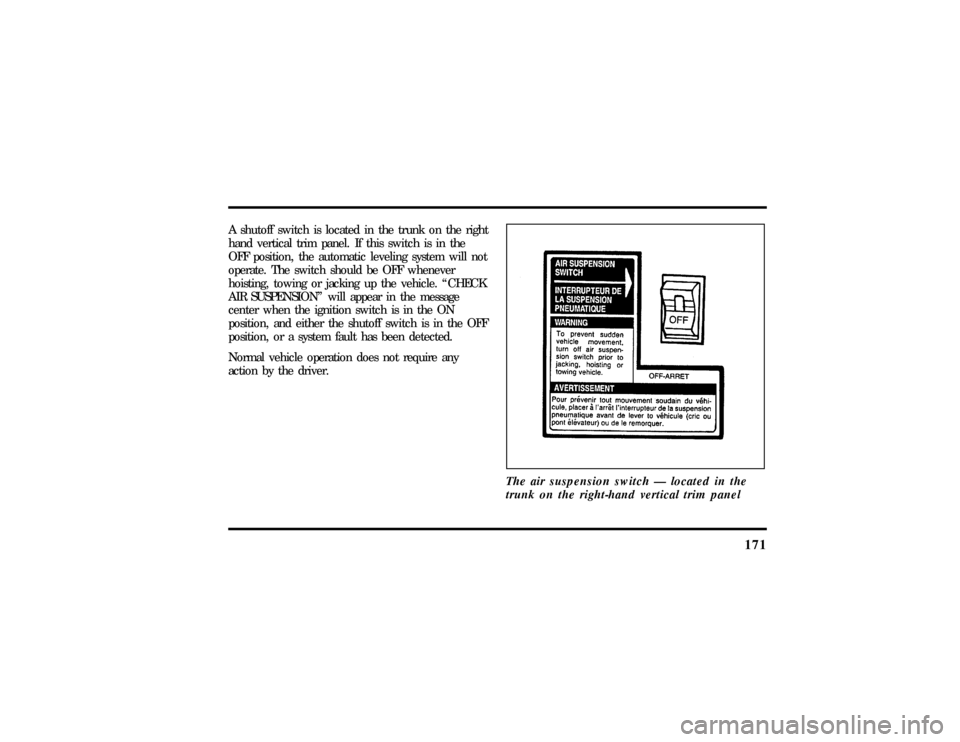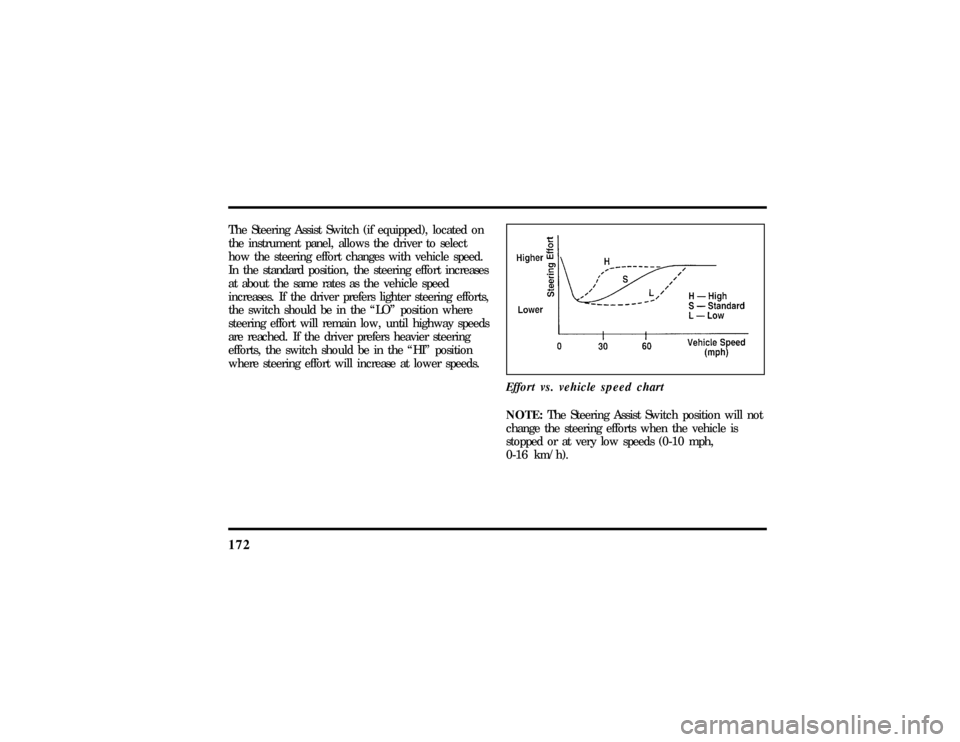LINCOLN TOWN CAR 1997 Owners Manual
TOWN CAR 1997
LINCOLN
LINCOLN
https://www.carmanualsonline.info/img/15/7040/w960_7040-0.png
LINCOLN TOWN CAR 1997 Owners Manual
Trending: fuel fill door release, dashboard warning lights, service interval, spare tire, fuel cap release, hood release, start stop button
Page 171 of 305
168
lightcome son at an ytim eothe rtha nrigh tafter
WARNING
Alway sse tth eparkin gbrak efull yand
Page 172 of 305
169
WARNING
If th eparkin gbrak eis full yreleased,
WARNING
To preven tpersona linjury ,do not
Page 173 of 305

170Traction Assist
TM
(If equipped)
Your vehicle may be equipped with the optional
Traction Assist
TM
system. This system helps prevent
wheel spin in order to improve tire traction and is
an especially useful feature when you drive in hilly
areas or on slippery, icy or snowy roads.
Traction Assist
TM
works automatically by rapidly
applying and releasing the brakes to prevent one or
both of the rear drive wheels from spinning during
acceleration.
During the Traction Assist
TM
function, which most
often occurs during low speed acceleration on
slippery surfaces, a noise may be heard coming from
the engine compartment. This is normal and may
last for a few seconds during the acceleration of the
vehicle.
In general, this system improves your vehicle's
stability and acceleration performance when road
conditions warrant. Traction Assist
TM
is fully
effective up to approximately 25 mph (40 km/h).At 25 mph (40 km/h) the function begins to taper
off until it no longer operates above 34 mph
(55 km/h).
If the Traction Assis;
TM
system is cycled excessively,
the system will shut down to prevent the rear
brakes from overheating. A cooling down period is
required to prevent damage to the brakes. This time
period varies and depends on brake usage during
the cooling down period. Anti-Lock braking is not
affected and will function normally during the cool
down period.
After the cool down period, the Traction Assist
TM
function is restored.%Rear Air Suspension SystemYour vehicle is equipped with an automatic load
leveling rear air suspension system. This system
maintains the rear vehicle height at a constant level
by automatically adding air or releasing air from the
rear air springs to offset changes in vehicle loads.
File:09fngft.ex
Update:Mon Jun 17 13:52:03 1996
Page 174 of 305
171
A shutoff switch is located in the trunk on the right
hand vertical trim panel. If this switch is in the
OFF position, the automatic leveling system will not
operate. The switch should be OFF whenever
hoisting, towing or jacking up the vehicle. ªCHECK
AIR SUSPENSIONº will appear in the message
center when the ignition switch is in the ON
position, and either the shutoff switch is in the OFF
position, or a system fault has been detected.
Normal vehicle operation does not require any
action by the driver.
The air suspension switch Ð located in the
trunk on the right-hand vertical trim panel
File:09fngft.ex
Update:Mon Jun 17 13:52:03 1996
Page 175 of 305
172The Steering Assist Switch (if equipped), located on
the instrument panel, allows the driver to select
how the steering effort changes with vehicle speed.
In the standard position, the steering effort increases
at about the same rates as the vehicle speed
increases. If the driver prefers lighter steering efforts,
the switch should be in the ªLOº position where
steering effort will remain low, until highway speeds
are reached. If the driver prefers heavier steering
efforts, the switch should be in the ªHIº position
where steering effort will increase at lower speeds.
Effort vs. vehicle speed chart
NOTE:The Steering Assist Switch position will not
change the steering efforts when the vehicle is
stopped or at very low speeds (0-10 mph,
0-16 km/h).
File:09fngft.ex
Update:Mon Jun 17 13:52:03 1996
Page 176 of 305
173
WARNING
Holdthebrak epeda ldow nwhil eyou
Page 177 of 305
174
transmissionou tof th e P (Park )positio nwithout
WARNING
DO NO TDRIV EYOU RVEHICLE
Page 178 of 305

175
R (Reverse)With the gearshift in the R (Reverse) position, the
vehicle will move backward. You should always
come to a complete stop before shifting into or out
of R (Reverse).N (Neutral)With the gearshift in the N (Neutral) position, the
vehicle can be started and is free to roll. Hold the
brake pedal down while in this position.DrivingYour vehicle's gearshift is on the steering column.
The Transmission Control Switch (TCS) is located
on the end of the gearshift lever. The Transmission
Control Indicator Light (OVERDRIVE OFF) is
located on the instrument panel. You can put the
gearshift lever in any of the several positions.
The OVERDRIVE OFF light is off (not illuminated)
during normal vehicle operation. This allows the
transmission to upshift and downshift from 1stthrough 4th gears. When the TCS is pressed, the
Transmission Control Indicator Light will illuminate
(OVERDRIVE OFF) on the instrument panel. When
this OVERDRIVE OFF is illuminated the
transmission will upshift and downshift from 1st
through 3rd gears.
If OVERDRIVE OFF light does not come ªONº
when TCS is depressed or if the light flashes when
you are driving, have your vehicle serviced at the
first opportunity. If this condition persists, damage
could occur to the transmission.
To return the transmission to normal operation (1st
through 4th gear) depress the TCS again. This
switch may be used to cancel overdrive any time
the vehicle is being driven. Each time your vehicle
is started, the overdrive system will automatically be
in the normal overdrive mode and the light will not
be illuminated.
File:09fngft.ex
Update:Mon Jun 17 13:52:03 1996
Page 179 of 305

176Overdrive is the usual driving position for an
automatic overdrive transmission. It works the same
way Drive works, automatically upshifting or
downshifting as the vehicle speeds or slows.
However, Overdrive also shifts into a fourth gear Ð
an overdrive gear Ð when your vehicle cruises at
an appropriate consistent speed for any length of
time. This fourth gear will increase your fuel
economy when you travel at cruising speeds.When to use Drive (jÐ with
Transmission Control Switch activated)Overdrive may not be appropriate for certain
terrain. If the transmission shifts back and forth
between Third and Fourth gears while you are
driving on hilly roads or if your vehicle does not
have adequate power for climbing hills, depress the
TCS.
You can depress the TCS at any speed.
When to use 2 (Second)Use 2 (Second) for start-up on slippery roads or to
give you more engine braking to slow your vehicle
on downgrades.When to use 1 (Low)Use 1 (Low) when driving down steep grades. It
gives more engine braking to slow your vehicle than
2 (Second) on the downgrades. You can upshift
from 1 (Low) to 2 (Second) or from 1 (Low) to
Overdrive at any speed.P (Park)Always come to a complete stop before you shift
into P (Park). Make sure that the gearshift is
securely latched in P (Park). This locks the
transmission and prevents the rear wheels from
rotating.
File:09fngft.ex
Update:Mon Jun 17 13:52:03 1996
Page 180 of 305
177
WARNING
Alwaysse tth eparkin gbrak efull yand
WARNING
Neve rleav eyou rvehicl eunattended
WARNING
Do no texcee dtheGVW Ror the
Trending: audio, hood open, headlamp, display, glove box, Module, Seat









